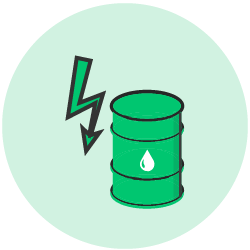Commodities ETFs, funds & risks
On this page you'll find:
The Best ETFs Australia commodities sector includes funds and ETFs which invest in:
- Gold - physically-backed or synthetic
- Platinum - physically-backed or synthetic
- Silver - physically-backed or synthetic
- Other precious metals
- Oil & energy

Synthetic vs. Physically-backed
Typically, "Synthetic ETFs" are commodity ETFs that provide investors with exposure to an asset class (e.g. gold prices) but they do not own the underlying asset (gold bars). They do this with derivative contracts.
"Physically-backed" ETFs have arrangements in place (including storage, safe storage and insurance) to physically own the underlying asset (e.g. gold bars). You will find information on where and who holds the gold, as well as some key risks associated with the arrangement, in the ETF's product disclosure statement (PDS).
What's better?
It depends on the ETF, asset class and arrangements in place. Typically, physically-backed ETFs are considered safer because they have a claim on the underlying assets.
Commodities Sector Risks
When you invest in commodities (like gold, silver or oil), some academic studies show you may be lowering some of the risks in a diversified portfolio. For example, you won’t have all of your eggs in your ‘Australia basket’.
However, our emphasis is on the some. Investors considering investing a meaningful amount of money in commodities should strongly consider getting expert financial advice before making an investment decision.

Factually speaking, some of these risks to commodities include:
- Market/price risk – we believe predicting the price of gold, oil and other commodities with certainty is impossible. If you choose to invest in a commodity ETF you must accept that the value of your investment could be significantly influenced by factors outside of your control, including political, regulatory and financial risks; and gold production and demand risks, to name a few. Often, the price of some commodities will move higher with global uncertainty. However, there are no guarantees this will happen in the future.
- Sovereign/regulatory risks – governments and regulators throughout the world can change their policies on inflation, trade, investing, taxes and even the rights of people and investors. Australia has a very stable and robust financial, legal, political and societal system — many countries don’t.
- Supply of commodities – supply and demand for gold, silver, platinum and oil can work for you or against you. Prices are often influenced by investor demand, competing uses for the commodity (e.g. jewellery, LNG) and macroeconomic factors (e.g. inflation, US interest rates). Supply can be impacted by miners’ exploration and production success and large financial institutions (e.g. investment banks and central banks).
- Liquidity risk – if we experience a shortage of commodities and spike in demand there’s a chance the price of a commodity could jump but the price of the ETF (inside your share brokerage account) could rise even higher. This would create a situation in which you, the investor, could overpay for the actual commodity which will be bought by the ETF issuer.
- Synthetic exposure – many commodity ETFs will NOT physically own or store a commodity (e.g. oil) on behalf of its investors. Instead, they’ll use derivative contracts to get you exposure to the commodity. This can create significant risks such as counterparty risk (see below) and delivery risk. Make sure you read the PDS of the ETF you’re considering before you invest. The PDS will tell you where the commodity is — or isn’t — stored. The PDS should be available on the ETF issuer’s website.
- Counterparty risk & holding structure – some ETF issuers use complicated holding structures to get you exposure to the underlying investment overseas. In Australia, ASX-listed shares and ETFs use the same system to ‘settle’ transactions and ‘hold’ your ETFs in your name, it’s called the CHESS system. However, if the ETF invests in overseas assets and commodities, it’s likely those assets will be held using another system or holding structure governed by other rules. Rest assured there are some safeguards in place. However, you should always do your research, read the ETF’s PDS or consult a licensed financial adviser. Is your commodity ETF insured against loss or theft?
- FX/currency risks – A big reason many investors put their money overseas is to get exposure to another country’s currency. For example, if you invest 1 AUD into US Dollars at a currency exchange rate of 1.00, you will get 1 USD in return. If the USD gets stronger (meaning the Aussie dollar exchange rate falls), your 1 USD is now worth more! However, it can go in the opposite direction. For example, if the AUD-USD goes to 1.10, your 1 USD (bought at a lower exchange rate) is now worth less in AUD terms than before. This risk is the reason why some ETFs are currency ‘hedged’ — to avoid the impact of currency fluctuations.
List of ETFs to watch
Uh-oh! There is no list to display for this sector. Use the links below to navigate back to our full list of funds.
Something missing?
This brilliant (and free!) report is issued by Best ETFs Australia, a division of The Rask Group Pty Ltd. It is not a recommendation.
Speak to a financial professional before relying on this information and please read our Financial Services Guide (FSG).
